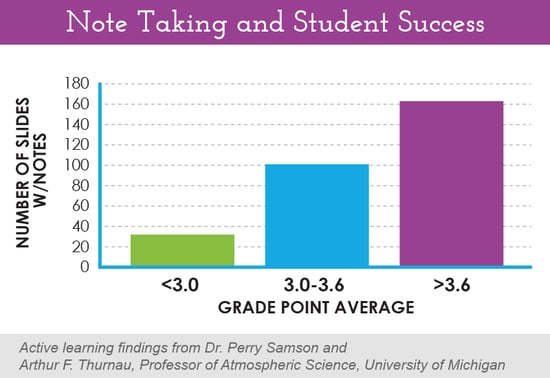
Freshman students bring an average of 3.5 devices to campus with them on the first day of school. More and more students are choosing to use these devices to take notes versus trying to hastily scribble every other word during a 60-minute lecture. Is this a good thing?
Picture today’s classroom. Most students have their heads buried behind a laptop screen, taking notes in Microsoft Word or Evernote (or surfing social media). Now imagine that on their screen is the instructor’s presentation and they are typing their notes on a tool completely synchronized with the context of the lecture. After class, these notes are available with the course video too. Everything is in one place: the course video, student notes and the instructor’s materials. That’s what a modern lecture capture solution can do for you. (Check out the June 4 blog to learn more).
Students now have their notes alongside their current course content in a take-anywhere digital study guide – no more lost notes or illegible coffee-stained transcriptions.
While this sounds like a much easier and better way to take notes, does it actually enhance learning and lead to better outcomes? What do the analytics relating to note taking in this new solution tell us about students’ participation behavior?
Dr. Perry Samson of the University of Michigan recently studied his students’ note taking habits using analytics in the Echo360 Active Learning Platform and uncovered some interesting correlations between note taking behaviors and student GPAs.
Not surprisingly, he found that the number of times notes were taken was strongly related to improved exam scores. And students coming into the class with higher GPAs were more likely to use the notes feature in the platform than their peers with lower GPAs. In fact, the number of notes taken increased by a factor of more than four between GPA < 2.5 to GPA > 3.5.
University of Ottawa’s Dr. Colin Montpetit also found that when he gave his students a digital platform to take notes, they were more likely to participate and engage with his content. In his large enrollment Genetics course, he observed 66 percent of students using the Echo360 solution to take notes with an average of 300-500 words typed per class. With an average of 18 slides per lecture, his students were typing notes on 13 of them, giving them deeper exposure and engagement with his content. He believes that giving his students a platform that enables better note taking and tools to participate anonymously in class was a major component in achieving a 3-10 percent increase in final exam scores.
Both of these seasoned instructors have seen the difference digital note taking makes when it comes to getting students more engaged with the content, providing an on-demand study resource, and ultimately, boosting learning outcomes.

